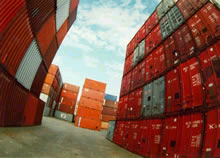forum
library
tutorial
contact

Well, There's Good News and There's Bad News
by Staff & Associated PressCalTrade Report, November 24, 2004
|
the film forum library tutorial contact |

|
Well, There's Good News and There's Bad Newsby Staff & Associated PressCalTrade Report, November 24, 2004 |
Los Angeles, Long Beach ship backlog eases, but terminal congestion continues
LOS ANGELES -- The backlog of ships calling at the ports of Los Angeles and Long Beach has been cleared, but the difficulties in moving containers in and out of terminals at both ports continues to be a major challenge, according to industry observers.
 The most recent report from the Los Angeles/Long Beach Marine Exchange - the region's vessel operating service - said that only seven ships were anchored outside the ports' shared breakwater as of last Friday, a significant drop from the 40-plus ships that were reported earlier this month.
The most recent report from the Los Angeles/Long Beach Marine Exchange - the region's vessel operating service - said that only seven ships were anchored outside the ports' shared breakwater as of last Friday, a significant drop from the 40-plus ships that were reported earlier this month.
Last week, the time needed for ships berthing at the ports' facilities to be "turned around" - that is, loaded and unloaded - didn't exceed four or five days compared with the seven days or more that became the average over the past three months.
Credit for breaking the bottleneck, the Marine Exchange said, goes to the influx of more than 3,000 newly hired longshoremen to work the ships, the decline in cargo volume due to the end of the so-called pre-holiday season "cargo crunch," and the diversion by some ocean carriers of ships to other less congested ports like Oakland, Seattle, and Portland.
For example, just a few days ago Korea-based Hanjin Shipping modified its Asia-US Pacific Coast service with a new rotation that included its first call at the Port of Portland.
According to a manager with the company, "We had a larger ship come to the Pacific Northwest and sent a slightly smaller one to Southern California," telling the Portland Business Journal that "a relatively small ship can be unloaded in about 16 hours, compared with a larger ship, which could take as long as three days."
Despite the positive development though, moving containers in and out of the huge terminals at both ports continues to cause headaches with gate delays and a continuing lack of intermodal rail equipment keeping containers bottled-up in the terminals and out of the logistics pipeline linking the region with the rest of the country.
Speaking with the Associated Press, Patty Senecal, vice president of Transport Express Inc., a trucking and warehouse company in nearby Rancho Dominguez, said, "The ships may be gone, but the congestion is not gone."
The problem, she said, "is now on the docks, at the gates. Now the challenge is on my side, everyday we're dealing with endless congestion and delays."
James McKenna, president and chief executive of the Pacific Maritime Association (PMA), told the AP that congestion at the port terminals "could still result in some cargo delays."
The San Francisco-based PMA negotiates the contract between the International Longshore and warehouse union (ILWU) and the ocean carriers and terminal operators that serve West Coast ports.
McKenna, the wire service reported, "acknowledged improvements need to be made" to the railroad system that serves the two ports - the busiest in the country and, if combined, the third busiest in the world - "to ease the cargo logjam on the ground."
Plans to expand next year the hours trucks can pick up cargo at the terminals "should also help," he said referring to the plan to extend gate hours at the facilities to nights and weekends.
In a related issue, the US Department of Transportation (DOT) has unveiled a new plan to help address the issues surrounding expansion at both ports and their ability to handle the surge of two-way cargo expected to flow through Los Angeles and Long Beach over the next 20 years.
According to figures from the Association of American Port Authorities (AAPA), both ports combine to handle a staggering 43% of all cargo container traffic destined for the US, and a full 40% of all imports coming into the country from China and the rest of Asia.
The DOT's new Southern California Gateway Initiative calls for an "ombudsman" based at the port of Long Beach to monitor activity at both ports and report directly to the Secretary of Transportation and the US Maritime Administrator in Washington, DC.
"A growing US economy has kept the nation's largest port complex in Southern California busy with ships carrying cargo destined for manufacturers and store shelves across the country. As freight volumes continue to escalate, it is critical that this port complex remain able to keep the nation's economy moving," said a statement from the DOT.
At the same time, the Transportation Security Administration (TSA) has begun testing the Transportation Worker Identification Credential (TWIC) program at the Long Beach Container Terminal (LBCT) at the Port of Long Beach.
The TWIC is a tamper-resistant credential that contains biometric information about the holder - a fingerprint, a handprint or an iris scan of the eye - so that entities like terminal operators and port authorities can verify identity and prevent unauthorized individuals from accessing secure areas.
The test will expand to 34 sites in six states and will last seven months, the agency said, adding that the program will eventually require background checks and identification cards for 6 million truck drivers, dock workers and cargo handlers at US ports, airports, and railroads.
Once the test is complete, the TSA will analyze the results to determine how the program will be implemented nationwide.
learn more on topics covered in the film
see the video
read the script
learn the songs
discussion forum
